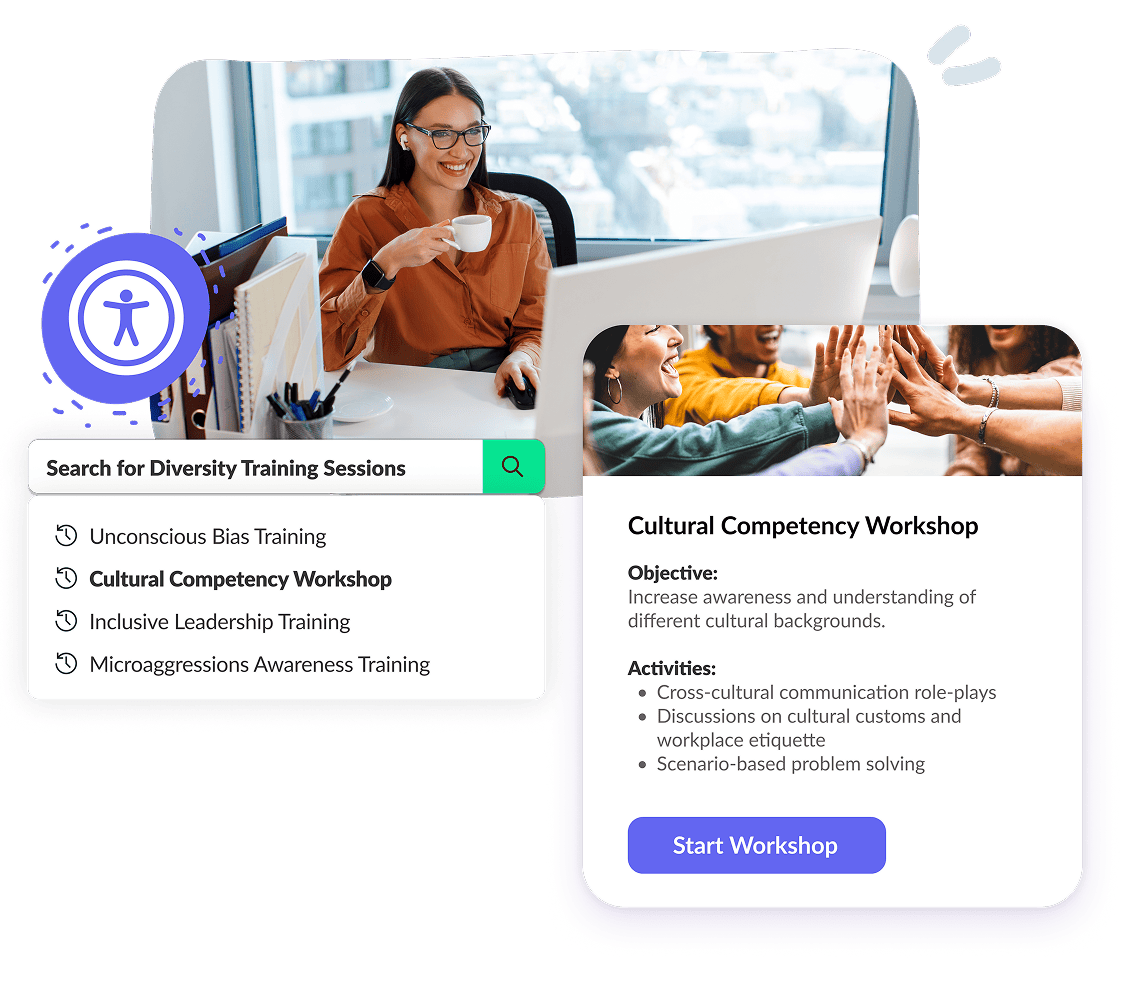Diversity in the Workplace

What Is Diversity in the Workplace?
Diversity in the workplace refers to the various demographic, psychographic, and other qualitative differences that exist among an organization’s workforce. Diversity, Equity, and Inclusion, which is more commonly shortened to “DEI”, can take into account each of the following examples, and many others:
- Age
- Cultural background
- Values
- Life experiences
- Race
- Beliefs
- Religion
- Educational level
- Geographical location
- Gender
- Physical abilities
- Socioeconomic background
- Sexual orientation
A diverse workplace has people of all ages, values, individual characteristics, cultural backgrounds, beliefs, life experiences, education levels, races, religions, genders, sexual orientations, and physical abilities. Policies on diverse hiring vary across states and countries, meaning both employers and job applicants will need to be aware of the benefits and restrictions that exist.

What Are the Benefits of Diversity and Inclusion in the Workplace for Employers?
While workplace diversity in the past focused on compliance with laws such as Title VII of the Civil Rights Act of 1964 and The Age Discrimination in Employment Act of 1967, organizations have learned that they benefit from diversity in ways that profit the company both culturally and financially.
There are demonstrated correlations between business performance and a company’s diversity. A 2019 McKinsey study found that companies with diverse executive teams are 25% more likely to show above-average profitability.
There are four categories of diversity:
Organizational Diversity:
Job function, employment status, pay type, management status, seniority, place of work, union affiliation
Internal Diversity:
Cultural identity, age, assigned sex, gender identity, ethnicity, national origin, neurodiversity, race, physical ability, sexual orientation
External Diversity:
Citizenship, appearance, familial status, education, location, life experience, religious belief, relationship status, socioeconomic status
Worldview Diversity:
Moral compasses, cultural experiences, travel experience, outlook on life, political affiliations

Other McKinsey reports that demonstrate financial gains obtainable by companies with diverse workforces include Delivering Through Diversity (2018) and Diversity Wins: How Inclusion Matters (2020).
Example:
In hiring, an example of diversity can mean making a conscious effort to hire people who belong to underrepresented groups. Equally important, using diverse interviewers in the hiring process can ensure that candidates feel represented. One way a company can ensure that it is hiring a diverse workforce is to use a blind application process.
What Are the Benefits of Workplace Diversity for Employees?
Besides the benefits to the company, diversity in the workplace gives employees a more inclusive working environment. Moreover, McKinsey’s reports showed that the majority of team members support diversity, with 52% of employees saying that diversity in the workplace is positive.
Employers that foster diversity in the workplace focus on six action areas:
- Strengthening leadership capabilities and accountability
- Ensuring that diverse employees are well represented
- Tackling discrimination, microaggressions, and bias
- Enabling equality of opportunity
- Being transparent and fair
- Fostering a sense of belonging through support for the many ways diversity manifests
Example:
To have diversity in the workplace, employers can have people of differing characteristics working side-by-side rather than segregating specific individuals. For example, a programming team should consist of people of all genders, ages, races, and cultural backgrounds. Another example is roles that have traditionally been gender-specific can be filled by either women or men.
What Is Diversity Training?
Diversity training is an educational strategy companies use to help instill more understanding between employees across different cultural and ethnic backgrounds. These trainings often fall into one of three categories:

Awareness-based training:
Training sessions designed to help employees recognize biases (both in themselves and others) and stereotypes. The goal is to build cultural awareness and sensitivity to help create a more inclusive and cohesive work environment.
Skills-based training:
Training sessions designed to improve employees' interpersonal communication skills, particularly within cross-cultural interactions. Sensitivity trainings and accountability trainings generally fall within this category.
Compliance-oriented training:
Training sessions designed to ensure employees (typically managers or above) are both aware of and actively following guidelines that govern engagements in the workplace that fall within the realm of DEI, such as anti-harassment, ADA compliance, and Title VII.
Diversity training should be utilized strategically and with forethought. A 2016 Harvard Business Review (HBR) study found that mandatory diversity training tends to have a negative impact instead of a positive one, particularly on the populations it’s intended to help. Instead, companies should provide voluntary diversity training, cross-training, and mentoring programs.
Companies will see more diversity training benefits primarily with intentional action and data tracking. In the same study, they found that when done well, diversity training can result in:
- More formal and informal mentorship among women and racial minorities
- Increased willingness to acknowledge racial biases
- More frequent acknowledgement of excellent work from peers within racial minority groups
A strategic approach to training is still warranted to increase the likelihood of success. Leaders responsible for creating and directing diversity training should be conscious of what their organization needs most. Trainings should be delivered in a way that recognizes and celebrates differences while focusing on how employees can navigate those differences that benefit themselves and the organization.

Diversity Hiring Best Practices and Strategies
Diversity hiring is the practice of recruiting and hiring people from diverse backgrounds, including individuals of different sexual orientations, races, religions, genders, educational levels, physical abilities, cultural backgrounds, and other personal characteristics.
Organizations committed to diversity in all aspects of the recruiting, interviewing, and hiring process have diverse recruiters and hiring managers.
Many companies follow the U.S. Equal Employment Opportunity Commission (EEOC) guidelines for ensuring diversity in hiring, but there are additional steps companies can take to ensure that their diversity recruitment and hiring process is solid.
- Audit the current recruiting and hiring process, identifying the strengths and challenges.
- Set a yearly or bi-annual goal of choosing one metric for improvement.
- Re-word job postings to use more inclusive language.
- Examine the images and videos used in promotional materials to ensure that a diverse workplace is represented.
- Encourage employee referrals from existing diverse team members.
- Use pre-hire personality assessments that help employers increase workplace diversity.
- Conduct blind hiring, a technique that makes personal information about candidates anonymous.
Example:
Besides hiring diverse individuals, having representation in the hiring process also shows a company’s commitment to a inclusive hiring policy. For example, a panel interview representative of the talent pool can make candidates feel more included. Companies can achieve this by having people of various races, genders, abilities, and sexual orientations conduct a panel interview.
Companies should also ensure that their diversity hiring practices do not create resentment. A 2023 Pew Research study found that 14% of employees believe their company focuses too much on DEI. Such feelings can cause some employees to negatively view anyone who is from a minority background that’s hired into the company as a “diversity hire.” This term is used to refer to an individual who was hired not on merit, but to meet a specific diversity quota.
Effective hiring practices can reduce these feelings, but may not completely eliminate them. Leaders should be conscious about the need to ensure every employee, regardless of their background, is shown to be an effective hire for the role that they fill.
Related Terms
DEI Policy
Diversity, Equity, and Inclusion (DEI)
Diversity, Equity, Inclusion, and Belonging (DEIB)
Dimensions of Diversity
Equal Opportunity Employment (EOE)
Frequently Asked Questions
Why is diversity in the workplace important?
Diversity in the workplace is important because of its proven benefits to business goals and company culture. Companies that focus hiring activities on creating a diverse workplace tend to see better financial outcomes, increased mentorship, and better alignment with employee wants and needs.
How do you increase diversity and inclusion at work?
To increase diversity and inclusion at work, companies should conduct audits of their hiring practices to ensure that people from historically underrepresented groups are not excluded or discriminated against in the hiring process. Additionally, employers should offer voluntary DEI training opportunities and create community spaces that foster communication.
What are the four types of workplace diversity?
The four types of workplace diversity include internal diversity (such as cultural identity, age, gender, or ethnicity); external diversity (such as citizenship status, appearance, familial status, or educational attainment); organizational diversity (such as job function, pay type, or union affiliation); and worldview diversity (such as political affiliation, cultural experiences, or life outlook).
What are the consequences of a lack of diversity in the workplace?
A lack of workplace diversity often creates the “echo chamber” effect at work. Companies without a diverse workforce are less likely to be innovative, respond more slowly to external changes that impact the company, and are more likely to show below-average profitability.